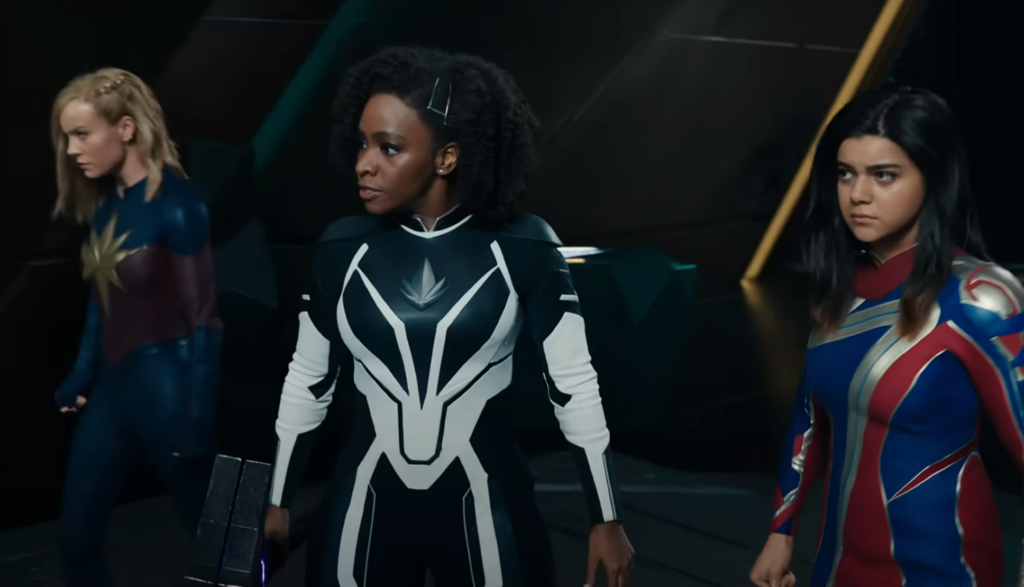
Carol Danvers goes by a lot of names.
To Nick Fury, she’s Carol “Avenger” Danvers and the reason he began the Avengers Initiative back in 1995.
To Kamala Khan, she’s Captain Marvel, Kamala’s favorite Avenger and inspiration for Kamala’s own superhero moniker, Ms. Marvel.
To Monica Rambeau, she’s Aunt Carol, who went off to defeat the Supreme Intelligence (an artificial intelligence that held Carol captive among the Kree aliens for six years) and then never returned.
And to the Kree, she’s the Annihilator. Because after Carol’s battle with the Supreme Intelligence, the Kree’s home planet of Hala fell into ruin—their atmosphere was stripped of breathable air, their oceans dried up, their sun burnt out.
Carol wants to right some of these wrongs, but she can’t do it alone. She’ll need help from the equally marvelous Kamala and Monica to save the universe from total annihilation at the hands of Dar-Benn, a Kree warrior bent on avenging the damage Carol inadvertently unleashed.
In Carol, Monica and Kamala, we’re given three diverse female role models. Each has a desire to do good, to make the world a better place. They build one another up. They support one another. And they risk their lives to protect the ones they love and save the universe.
But each also learns a hard lesson about heroism.
Carol learns about taking responsibility for her actions—both toward the Kree and toward Monica. And she recognizes that she had let pride keep her away from the people she loves most.
Monica discovers how to be brave, to embrace the gifts she’s been given and to forgive.
Kamala realizes that even with superpowers, there are limitations to what she can accomplish—and she learns to accept that she can’t save everyone.
And they all learn, to one degree or another, that there are consequences for the choices they make, however well-intentioned.
Kamala’s family, the Khan,s are a strong and loving family unit. Sure, they disagree sometimes. Kamala’s parents staunchly oppose her decision to join Carol and Monica on their mission to save the universe. However, they ultimately realize that (to quote another Marvel character) with great power comes great responsibility. And they decide to support Kamala, reminding her constantly how much they love her and how proud they are of her.
When Kamala offers to drop out of school to help Carol, Carol firmly tells her not to.
It goes without saying, but I’ll say it anyway: These three heroes (along with plenty of other secondary characters) act heroically and sacrificially to save each other and to keep Dar-Benn from unleashing her world-wrecking plans to the fullest.
Having said that, we could even go so far as to say Dar-Benn isn’t totally evil herself. One of her core desires is to provide for her people, the Kree, who have suffered in the wake of their own homeworld’s environmental degradation. Unfortunately, as we’ll see, that altruistic desire exists side by side with her even stronger impulse to have her revenge on Carol.
In dealing with superpowers, we’re inherently dealing with spiritual matters. Carol’s powers are science-based, the result of a DNA-altering explosion in the events of Captain Marvel. But Monica got powers after walking through Wanda Maximoff’s “witch-hex” in WandaVision. (Though this film doesn’t say much more than that on the topic.)
Other characters, namely Kamala (who is also a mutant, per the Ms. Marvel series) and Dar-Benn, wield weapons imbued with powers. And that’s where this film spends a lot of time.
Kamala wears an ornate bangle called a Quantum Band that channels energy from an alternate, djinn-filled dimension. When Dar-Benn finds this bracelet’s twin, she uses it to rip holes in time and space. Her ultimate goal is to join the two bands together to destroy everything that Carol loves. And as a result of the bands’ power (they were used to create a universe-wide network of teleportation points), Dar-Benn nearly tears the whole universe apart.
There are also several alien species, some of whom have monstrous abilities (such as the tentacle-tongued, cat-like Flerken). A few characters’ eyes glow when they use their powers.
Kamala’s family members are Muslims, and we hear her brother saying a prayer during a scary moment. (Nick Fury encourages this, telling him they need “all the help [they] can get,” and repeatedly shouting “Amen!”)
Kamala’s father says that Fury has taken them to hell, and Nick supposes that makes him the devil in the Khans’ eyes. A character talks about going from one life to the next.
Carol wears a tight, mid-riff baring tank top in several scenes. We hear about a couple who married for political reasons, and it’s implied that they’ve never been intimate. Two women exchange a kiss on the cheek, but it appears to be a platonic greeting.
Goose, a Flerken, licks its private parts with its many tentacled tongue. [Spoiler Warning] Later, it lays many eggs that hatch into other Flerkens. And it’s unclear how the reproductive cycle works on this alien species.
Several battles take place between our heroes, their allies and the film’s villains. During these sequences, characters are shot, ships explode, and there’s a heavy exchange of superpowered kicks and punches. And while we don’t witness any onscreen deaths, it’s all but certain warriors are killed in these fights.
Carol, Monica and Kamala spend much of the film physically swapping places, a result of their contact with the time-space rifts Dar-Been created. Several of these are played for humor, but the first occurrence results in Monica and Kamala getting teleported from relatively safe locations into the middle of a battle with the Kree. And a later incident finds Kamala falling uncontrollably through the sky since, unlike Monica and Carol, she can’t fly. (Though she’s saved by another swap at the last second.)
One of these hero-swapping battles in the Khans’ New Jersey home draws Kamala’s parents and brother into a melee with Dar-Benn’s much more powerful lackeys. Kamala’s family members do what they can with various household items (a mop, for instance) to fight off the intruders.
Dar-Benn uses one of the Quantum Bands to tear an interdimensional hole in the atmosphere above a refugee planet. That portal begins to strip the atmosphere of air, vacuum-like, while also causing buildings to collapse. Carol, Monica and Kamala evacuate as many people as they can, but many are crushed by falling debris. Some are, despite the heroes’ best efforts, left behind to presumably perish.
A flashback shows Carol using her powers to destroy the Kree’s Supreme Intelligence and harm Kree warriors, including Dar-Benn. Subsequent flashbacks show how Hala, the Kree’s home world, was stripped of its atmosphere, oceans and sun in the resulting civil war after Carol vanquished the Supreme Intelligence, an AI overlord whom Carol believed kept the Kree people in slave-like thrall to itself.
Kamala and her family are horrified when a Flerken swallows a grown man whole. (Though it later spits the man back out unharmed—a humorous occurrence that’s repeated multiple times later in the story.)
Dialogue includes two uses of the s-word (including one in a post-credits scene). Lyrics in a soundtrack song add another s-word. There are also six uses of “h—” and two of “d–n.” And God’s name is misused nearly a dozen times (especially by Kamala, who has a penchant for dramatic exclamations of “Oh my god!”)
None.
Dar-Benn truly cares about saving the Kree, as I noted above. However, her mission to restore Hala is quickly overshadowed by her desire to avenge it—by destroying everything that Carol holds dear.
We hear about a woman’s death after battling cancer.
Dar-Benn feigns peace a couple of times before ultimately betraying the people who trusted her. Kamala lies to her parents about doing her homework.
We hear a story about a woman who vomited after changing an infant’s diaper.
Like any Marvel film, you have to take The Marvels with a grain of salt.
On the one hand, you have inspiring messages of heroism, self-sacrifice, and friendship. There are some positive female role models. And in my own humble opinion, we also get one of the funniest scenes that the Marvel Cinematic Universe has ever produced.
However, there’s also a lot of violence. Perhaps not as much as some other Marvel flicks, but still probably one battle too many—especially when you consider that people are dying in these fights.
We also have some language to watch out for. And since we are talking about superheroes, of course, there are the cosmic forces behind their powers that come into play. Some of this is scientific, some of it is supernatural, all of it is a bit mysterious.
It’s not entirely unnavigable for families willing to discuss these topics. But viewers will still need to be cautious about what they’re consuming as they make a decision about this latest MCU fare.
Having said that, however, the lessons shared by the movie’s three main heroines are often surprisingly earnest and sweet, making The Marvels one of the nicer MCU movies recently.


Emily studied film and writing when she was in college. And when she isn’t being way too competitive while playing board games, she enjoys food, sleep, and geeking out with her husband indulging in their “nerdoms,” which is the collective fan cultures of everything they love, such as Star Wars, Star Trek, Stargate and Lord of the Rings.